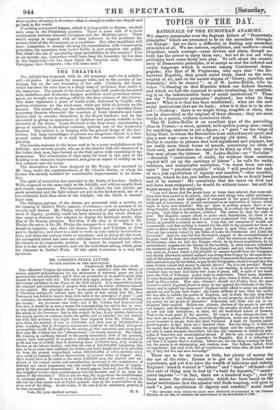THE THEATRES.
The Adelphi has reopened, with its old company, and—be it added— with old pieces. At present the manager relies, not on the novelty of her dramas, but on the new decoration of her salle. Certainly the house, which has been for some time in a dingy state of existence, does credit to the improvers. The panels of the boxes are light buff, profusely decorated with medallions and Arabesque designs, and these more prominent adorn- ments are brought out in strong relief by the deep crimson of the interior. The dome represents a piece of trellis-work, enlivened by Cupids, who perform evolutions on the slack-rope, while gay birds sit gravely on the summit. The artist's idea, say the authorities, has been to reproduce those temporary theatres wherewith the courtiers of Louis Quatorze and Louis Quinze used to recreate themselves in the Royal Gardens; and he has succeeded in giving an appearance of lightness and gayety, suitable to the character of the house. Least felicitous is the drop-scene, representing a group of courtiers, in theatrical costume, quitting one of the temporary theatres. The subject is in keeping with the general design of the deco- rations; but large assemblages of persons are dangerous objects in a fore- ground, unless finished in a style beyond the common run of scene- painting. The wooden staircase to the boxes used to be a great unsightliness at the Adelphi; and nervous people, who go to the theatre with the chances of a fire before their eyes, have looked on the frail egress with something of ap- prehension. The substitution of slate-stone for wood in this part of the building is an immense improvement, and gives an aspect of solidity on the first entrance into the house.
The decorations have been designed by Mr. Wyatt; and executed by Mr. Sang, under the superintendence of Mr. Charles Manby, to whom the theatre was already indebted for considerable improvements in its forma- tion.
The spirit of renovation has extended to the North of London: Sadler's Wells reopened on the same night as the Adelphi, and with an equally fresh and cleanly appearance. The decorations, in which the rich colours are made prominent and the light colours are put in the background, are of a less recherché kind than those of the Adelphi; but the whole is exceed- ingly neat.
The Islington patrons of the drama are presented with a novelty on the opening of Sadler's Wells; namely, Coriolanus,—new on account of its scenery and dresses. Mr. Phelps, who has a world of pathos but a limited stock of dignity, probably could not have selected in the whole Shakspe- rian range a character less adapted to display his histrionic merits, than that of the Roman patrician. But then, if the play is ill-suited to Mr. Phelps the actor, it fits Mr. Phelps the manager to a nicety. There is a senate to organize; and there are troops, Roman and Volscian, to dress and to discipline; and there is a mob to work up into orderly insubordina- tion; and there are antique views to introduce: and in doing all this work, the managerial talent has come out with that force which has already raised the theatre to its respectable position. It cannot be repeated too often, that it is the spirit of ensemble, and not the individual acting, which gives the character to Sadler's Wells. Of this spirit Coriolanus is a very fair specimen.


























 Previous page
Previous page